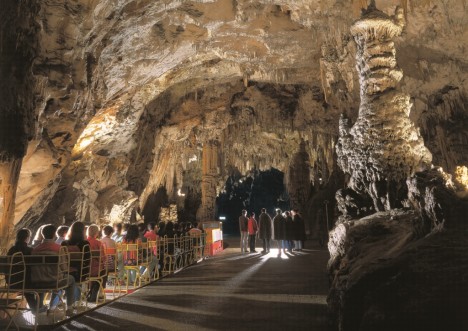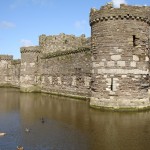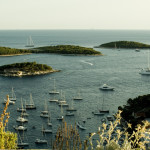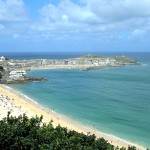140 Years of the Railway in Postojna Cave
16 June 2012 marked 140 years since the first ride with the underground train inside Postojna Cave.
Up until the early 19th century, when the inner parts of the cave were discovered by Luka Čeč on 14 April 1818, the cave was left open, without any protection, lighting or regular guiding services, and tours of the cave were possible on foot only. The discovery of »the new world, the paradise« gave rise to large numbers of visitors and also resulted in the construction of a bridge across Pivka River, new footpaths inside the cave and illumination.
In the first half of the 19th century, when the Austrian Southern Railway between Vienna and Trieste was being constructed, the idea of a section of the railway line to run through Postojna Cave was considered. The idea was rejected, it did however generate another one. Because of a growing number of visitors, the need for some sort of transport around the cave arose. On 11 March 1857, the Austrian Emperor Franz Joseph I and the Empress Elisabeth came for a visit and to avoid them having to do a lot of strenuous walking around the cave, three sedan chairs had been constructed for the empress and her ladies-in-waiting.
The empress saw a larger part of the cave on foot, but the sedan chairs were later available for hire for all other visitors. In 1872, the railway tracks were laid, along which waggons were pushed by cave guides. The entrance station was at the dripstone called Prižnica, as it was because of the terrain characteristics not possible to lay the railway track over the Great Dome. The tracks in the total length of 1534 metres were laid as far as the foot of Cavalry. The route through the cave did not have many ascents or descents, so a single cave guide was able to push waggons along the tracks on his own.
The Emperor Franz Joseph I, who visited the Postojna Cave again in 1883, used the first underground railway himself too. However, with the increasing number of visitors the small manually-operated railway no longer sufficed. The cave management started considering motor-driven carriages and the locomotive called »Montania« usually used in mines, with a petrol engine, and four-seat carriages were thus ordered in 1914 from the Orenstein & Koppel factory. Because of the outbreak of the First World War the delivery of the locomotive was considerably delayed, so the first ride around the cave with the »Montania« locomotive was not possible until 1924, after the renovation work and the final cave railway set-up was completed. The locomotive did four rides daily and in the course of the first year – between August 1924 and June 1925 – 15,588 visitors were taken around the cave with it. A new, more powerful locomotive »Montania«, which also had a petrol internal-combustion engine, but was a three-axis one, unlike the first two-axis one, was acquired in 1925. New carriages with six seats were also purchased.
During the cave ride, the train made a ten-minute stopover at the old post office, where cave visitors had the opportunity to send postcards featuring the cave postmark. In 1928, the platform at the entrance into the cave and the administrative building with the railway station were also completed. The cave visit system that had been in force ever since the engine-powered railway was introduced (i.e. cave tours possible either by train or on foot) was maintained up until the year 1963, when walking tours were done away with completely. After the Second World War, there was a rapid increase in the number of cave visitors, but the petrol engines used until then were old and worn-out, and were also the cause of heavy pollution, so two new battery-powered »Emam« locomotives were acquired in 1957.
As the number of visitors was on a constant increase, two other locomotives were added at a later time, in 1959 and in 1964. Visitor capacity at the time was 2,160 visitors a day. The biggest issue was locomotives turning on the single-track railway line, so only three locomotives could be inside the cave simultaneously. In 1959, the cave management thus commissioned the project of setting up a double-track circular railway line. The double-track line with a loop at the cave entrance and the terminus station at the end of the line, which represents the first stage of the railway modernisation, was opened on 20 June 1964.
The circular line, which was completed in 1967, is 3,700 metres in length. With its three platforms and tunnels in the total length of approximately 500 metres it is capable of taking over 14,000 visitors around the cave in a day, and can depart every half an hour. Up until the year 1978 there were twelve battery-powered locomotives in the cave, and by 1988, another six were acquired to replace the eight clapped-out ones.
By 2018, when the 200th anniversary of the discovery of the cave will be celebrated, the aim of the company Postojnska jama is to renovate the cave transportation system. Solutions will be sought among technologies that would reduce noise inside the cave, and preferably an automated transportation system will be chosen.

Postojna Cave First Trolley from 1872
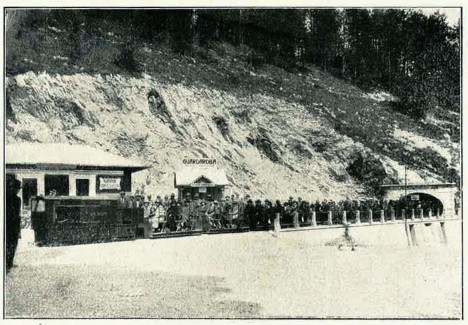
Postojna Cave Train outside before WW2
Article and pictures were delivered by Postojna Cave.






